Photos of Pluto and Its Moons
New Horizons' Zoomed-in Sunset View of Pluto
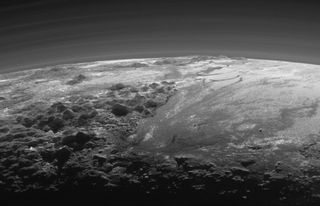
A zoomed-in view of a photo NASA’s New Horizons probe took on July 14, 2015, when it was just 11,000 miles (18,000 kilometers) from Pluto. The near-sunset scene, which is 230 miles (380 km) across, shows rugged ice mountains up to 11,000 feet (3,500 meters) high and wide, flat plains.
Sunset View of Pluto
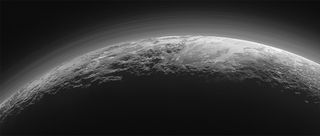
NASA’s New Horizons spacecraft looked back toward the sun 15 minutes after its closest approach to Pluto on July 14, 2015, capturing this near-sunset view of the dwarf planet’s icy mountains and flat ice plains. The image was taken from a distance of 11,000 miles (18,000 kilometers) from Pluto; the scene is 780 miles (1,250 km) wide.
Fog on Pluto
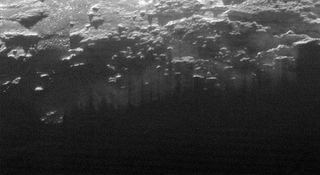
The setting sun illuminates fog or near-surface haze on Pluto in this small section of an image taken by NASA’s New Horizons probe on July 14, 2015, when it was 11,000 miles (18,000 kilometers) from the dwarf planet. The image covers a stretch of land 115 miles (185 km) wide.
Vast Ice Plains in Pluto's Heart
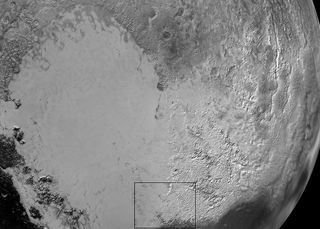
This image, a composite of several photos taken by NASA’s New Horizons probe, shows a vast Pluto ice plain called Sputnik Planum. The box shows the location of other detailed glacier images.
Flowing Ice on Pluto's Plains
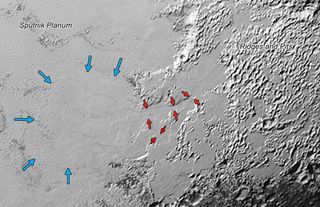
This New Horizons image shows how ice (probably frozen nitrogen) is flowing from Pluto’s mountains through valleys (outlined by red arrows) onto the plains known as Sputnik Planum; the “flow front” there is outlined by blue arrows in this photo, which covers an area 390 miles (630-kilometer) wide.
Flowing Ice on Pluto's Plains (2)
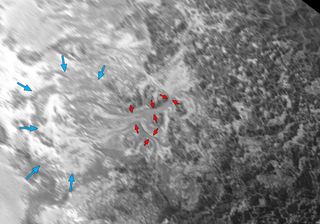
A backlit, oblique view of a New Horizons image showing how ice (probably frozen nitrogen) is flowing from Pluto’s mountains through valleys (outlined by red arrows) onto the plains known as Sputnik Planum; the “flow front” there is outlined by blue arrows in this photo, which covers an area 390 miles (630-kilometer) wide.
Mosaic of Sputnik Planum on Pluto
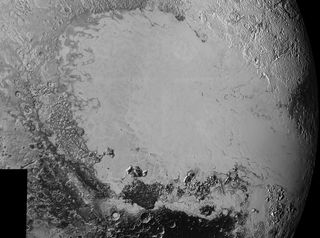
This mosaic, made of high-resolution images of Pluto sent back from NASA’s New Horizons spacecraft from Sept. 5 to 7, 2015, shows the icy plain Sputnik Planum (informal name), the bright region across the center.
Get the Space.com Newsletter
Breaking space news, the latest updates on rocket launches, skywatching events and more!
Broken Terrain on Pluto
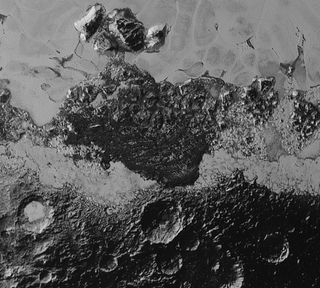
NASA’s New Horizons spacecraft shows a 300-mile-wide (470-kilometer) area of jumbled, broken terrain on the edge of Sputnik Planum (informal name) plain. Image released Sept. 10, 2015.
Perpective View of Pluto
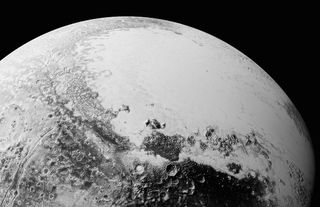
A perspective view of Pluto, based on the latest high-resolution images downlinked from NASA’s New Horizons spacecraft, gives the impression of looking down from a height of approximately 1,100 miles (1,800 km) above Pluto. Image released Sept. 10, 2015.
Range of Surface Features on Pluto
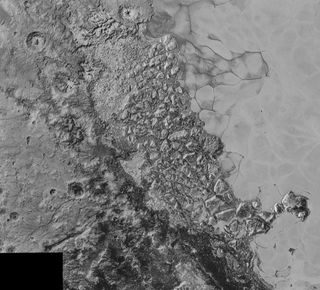
This image from NASA’s New Horizons spacecraft shows an area 220-mile (350-kilometer) wide on Pluto with very varied surface reflectivities and geological landforms. Image released Sept. 10, 2015.
Pluto's Moon Charon
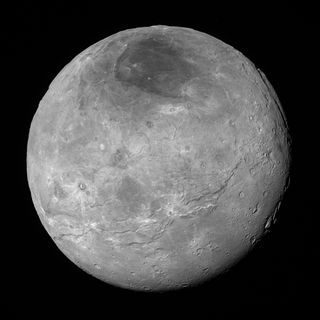
NASA’s New Horizons spacecraft sent back to earth a higher quality version of an image of Pluto's moon Charon first obtained on July 14, 2015. Image released Sept. 10, 2015.
Join our Space Forums to keep talking space on the latest missions, night sky and more! And if you have a news tip, correction or comment, let us know at: community@space.com.

Space.com is the premier source of space exploration, innovation and astronomy news, chronicling (and celebrating) humanity's ongoing expansion across the final frontier. Originally founded in 1999, Space.com is, and always has been, the passion of writers and editors who are space fans and also trained journalists. Our current news team consists of Editor-in-Chief Tariq Malik; Editor Hanneke Weitering, Senior Space Writer Mike Wall; Senior Writer Meghan Bartels; Senior Writer Chelsea Gohd, Senior Writer Tereza Pultarova and Staff Writer Alexander Cox, focusing on e-commerce. Senior Producer Steve Spaleta oversees our space videos, with Diana Whitcroft as our Social Media Editor.